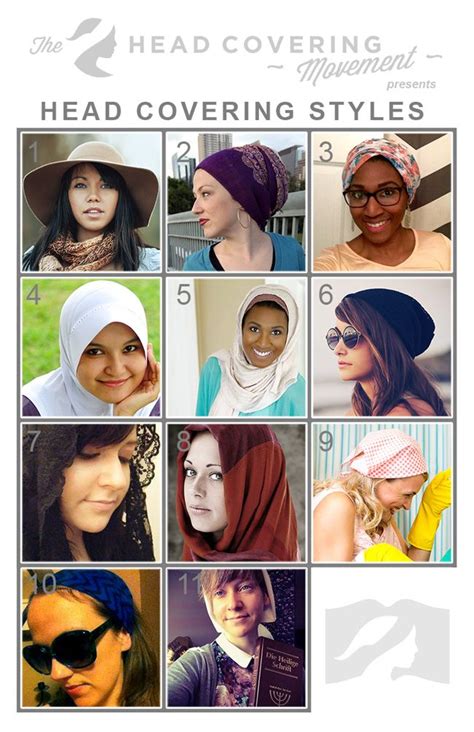In various cultures and religions around the world, head coverings for women hold significance as symbols of modesty, faith, or cultural identity. From the omnipresent hijab to the elegant mantilla, these coverings come in diverse forms and fabrics, each with its own unique story to tell.

Hijab
The hijab, a veil that covers the head and neck, is a cornerstone of Islamic dress code for women. According to the Pew Research Center, over 60% of Muslim women worldwide wear the hijab. Beyond its religious significance, the hijab has become a potent symbol of Muslim identity and a subject of considerable debate.
Niqab
The niqab, a full-face veil that leaves only the eyes visible, is worn by a minority of Muslim women. In some countries, such as Saudi Arabia, the niqab is mandatory in public spaces. In Western societies, it has often been met with controversy and resistance.
Mantilla
In Catholic tradition, the mantilla, an intricate lace veil draped over the head and shoulders, is worn by women attending church services and special occasions. It symbolizes modesty and reverence. According to a survey by the Pew Research Center, 72% of Catholic women in Spain wear a mantilla in church.
Burqa
The burqa, a full-body garment that covers the entire face and body except for a mesh opening for the eyes, is worn by some Muslim women in Afghanistan and Pakistan. It is the most restrictive form of head covering and has been the subject of much debate over its implications for women’s rights and freedom of expression.
Cultural Head Coverings
Beyond religious contexts, head coverings have played an integral role in various cultures. In many indigenous communities, women wear traditional head coverings as a symbol of cultural pride and identity. In Andean cultures, for instance, women often wear colorful shawls or hats known as “cholitas.” In India, the sari includes a “pallu,” a fabric panel that can be draped over the head.
Head Coverings in Fashion
Head coverings have also found their way into the world of fashion. In recent years, designers have incorporated headscarves, turbans, and other coverings into their collections, blurring the lines between religious and aesthetic expression. Celebrities such as Rihanna and Beyoncé have been spotted wearing head coverings as fashion accessories.
Benefits of Head Coverings
Beyond their religious and cultural significance, head coverings can provide certain benefits for women.
- Protection from the Sun: Head coverings can offer protection from the sun’s harmful UV rays, reducing the risk of skin cancer and sunburns.
- Privacy: Head coverings can provide women with a sense of privacy and anonymity in public places.
- Warmth: In cold climates, head coverings can provide warmth and insulation.
Tips and Tricks
- Choose the Right Fabric: The fabric of your head covering should be breathable and comfortable to wear. Cotton, silk, and linen are good options.
- Accessorize: Head coverings can be accessorized with pins, brooches, or other decorative elements to add personality and style.
- Experiment with Different Styles: There are many different styles of head coverings available, so don’t be afraid to experiment until you find one that suits you.
Common Mistakes to Avoid
- Avoid Overdressing: Head coverings should complement your outfit, not overwhelm it. Choose a simple style if you’re wearing a patterned dress or skirt.
- Don’t Wear Your Head Covering Too Tight: This can be uncomfortable and cause headaches.
- Be Respectful of Cultural Differences: When traveling to different cultures, be aware of the local customs and dress codes regarding head coverings.
FAQs
-
Why do Muslim women wear the hijab?
The hijab is worn as a symbol of modesty and religious devotion. In some Muslim countries, it is also a legal requirement. -
Is it okay to ask a Muslim woman to remove her hijab?
No, it is generally not considered appropriate to ask a Muslim woman to remove her hijab. It is a personal choice that should be respected. -
Can I wear a head covering if I’m not religious?
Yes, head coverings can be worn for fashion or cultural reasons. -
How should I style my head covering?
The are many different ways to style a head covering. You can experiment with different folds, pins, and accessories to create a unique look. -
What are the different types of head coverings?
There are many different types of head coverings, including the hijab, niqab, burqa, mantilla, and indigenous headwear. -
What are some of the benefits of wearing a head covering?
Head coverings can protect from the sun, provide privacy, and add style. -
What are some tips for wearing a head covering?
Choose the right fabric, experiment with different styles, and be respectful of cultural differences. -
What are some common mistakes to avoid when wearing a head covering?
Avoid overdressing, wearing your head covering too tightly, and being disrespectful of cultural differences.
Conclusion
Head coverings for women have a rich and varied history, with deep religious, cultural, and fashion significance. From the humble hijab to the extravagant mantilla, these coverings are a testament to the diversity and individuality of women around the world. By understanding the different types of head coverings and their significance, we can foster greater respect and understanding among cultures.
